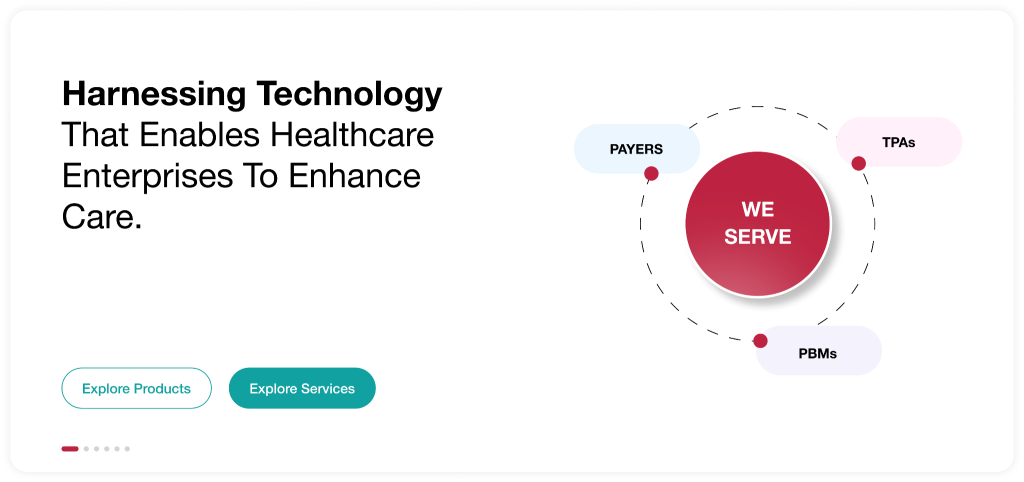
Around 75% of healthcare executives believe that Digital and AI Transformation is a high or top priority for their organisation (McKinsey & Company, 2024)
This shared conviction is not without grounds. Technology plays an important role in changing how healthcare enterprises operate. Today, Health Plans, PBMs, and TPAs are increasingly leveraging the power of technology to streamline business processes and elevate consumer experiences, reduce operational costs and improve service efficiency.
However, as healthcare enterprises begin their digital transformation journeys, they need to address several key considerations while seamlessly integrating new technologies into their existing digital landscape. These include concerns around data security, compliance, system interoperability challenges and resistance to change among others.
In this blog, we will define digital transformation in healthcare, explore its primary drivers, examine how it benefits an enterprise, identify emerging trends in the industry and highlight key considerations for a successful adoption.
Digital Transformation in Healthcare
Digital transformation in healthcare is a strategic and continuous process of leveraging advanced technologies to simplify, accelerate, and optimize the overall delivery of healthcare. It is not a one-off modernization initiative but a fundamental overhaul of a healthcare enterprise’s core business operations.
Primary Drivers of Digital Transformation in Healthcare
1. Changing Consumer Expectations/Evolving Consumer Needs
Today, healthcare consumers expect a seamless online experience that mirrors in-person interactions. They are looking for a single platform that meets their healthcare needs conveniently.
To stay ahead of these expectations, healthcare enterprises need to build advanced digital tools. In other words, they need to build portals and mobile health apps that offer customers personalized and omnichannel self-service experiences.
2. Evolving Regulatory Requirements
The Healthcare industry must follow strict rules to safeguard sensitive member data ensuring high-quality care delivery. The Health Insurance Portability and Accountability Act establishes privacy standards for patient health information. CMS and ONC interoperability laws ensure standardized interchange across systems.
These regulations continue to evolve, and healthcare enterprises need technology solutions that can ensure ongoing complaints. Only then can they ensure secure data management.
3. Increasing Competitive Pressure
With tech-driven health startups emerging in the market, the healthcare landscape becomes highly competitive by the day. Traditional healthcare enterprises have to keep face with the rapid innovation and agility of these startups. Only then can they effectively attract and retain consumers.
That is why they need to prioritize investment in technology. This will help them to differentiate themselves and maintain a strong position in the market.
Benefits of Digital Transformation in Healthcare
1. Elevated Consumer Experiences Through Intelligent Self-Service
One of the major pain points for healthcare consumers is spending excessive time on the phone with customer service agents to resolve simple queries. Intelligent self service portals eliminate this hassle.
Being a one-stop shop for consumers, they let them find answers independently. This means that they need no manual assistance for resolving simple issues.
2. Strengthened Financial Health With Predictive Analytics
Proactive risk assessment and fraud detection are fundamental for healthcare enterprises. It helps them maintain their financial health and ensure sustainable growth. By leveraging predictive analytics, healthcare enterprises can detect early signs of fraudulent activity, assess high-risk claims, optimize pricing and thus, prevent financial losses before they occur.
This approach safeguards businesses against losses and ensures that the claims are processed accurately and fairly.
3. Better Care Coordination With Interoperability
In a healthcare enterprise, seamless and secure exchange of critical healthcare data across internal and external systems ensures effective healthcare delivery. Disruptions and inefficiency in data exchange create gaps in communication. It distracts workflows and results in delays in care.
Healthcare enterprises can streamline data exchanges using interoperability solutions across multiple internal and external systems. This enhances stakeholder coordination and speeds up response times, facilitating more informed decision-making.
4. Enhanced Business Efficiency With Workflow Automation
To ensure seamless healthcare delivery, healthcare enterprises must efficiently manage numerous high-volume repetitive manual tasks across key business functions. This includes member enrollment, eligibility verification, prior authorization, claim adjudication, etc. By automating workflows, they can eliminate this manual intervention. This also minimizes the scope of errors, improving overall business efficiency.
Emerging Digitization Trends in Healthcare
1. The Rapid Adoption of Low-Code/No-Code Solutions
As healthcare organizations navigate the accelerating pace of digital transformation, the adoption of low-code and no-code solutions is emerging as a game-changer. These platforms benefit both technical and non-technical users. They can design, develop, and deploy applications with minimal coding effort, significantly reducing development timelines.
In the healthcare sector—where agility, compliance, and consumer-centric innovation are paramount—low-code/no-code solutions streamline processes like group/member onboarding, claims automation, and data integration. This rapid adoption reflects a broader trend toward faster innovation cycles, operational efficiency, and reduced dependency on traditional IT while maintaining the flexibility to adapt to evolving regulatory requirements.
2. The Rising Demand for Self-Service Experiences
In the era of digital-first healthcare, there is a growing demand for self-service experiences that empower users to access information and manage tasks independently. Members, providers, employers, and brokers increasingly expect seamless, on-demand access to essential services—ranging from viewing benefits and claims to managing enrollments and authorizations.
This shift is driven by the need for convenience, efficiency, and faster resolution times. For healthcare organizations, investing in intuitive self-service solutions not only enhances user satisfaction but also reduces operational workloads, allowing internal teams to focus on more complex, high-value tasks. As digital transformation accelerates, self-service experiences are becoming a cornerstone of modern healthcare delivery.
3. The Expanding Role of AI – Driven Automation
AI-driven automation is rapidly transforming the healthcare landscape, enabling organizations to streamline complex processes, enhance accuracy, and improve operational efficiency. From claims processing and prior authorizations to member engagement and data reconciliation, AI-driven solutions are reducing manual workloads while increasing speed and precision.
This shift not only drives cost efficiencies. It lets healthcare professionals to shift their focus on delivering higher-value care. As healthcare organizations continue to embrace digital transformation, AI-driven automation is becoming an essential tool for improving scalability, regulatory compliance, and personalized service delivery
4. The Vast Potential of Big Data Analytics
Big data analytics is unlocking new opportunities to enhance decision-making and optimize operational efficiency. By using a vast amount of structured and unstructured data—from member records and claims to provider networks and clinical research—healthcare organizations can uncover actionable insights that drive personalized care, predictive modeling, and cost management.
Big data analytics also plays an important role in identifying emerging health trends, improving population health management, and ensuring regulatory compliance. As healthcare systems evolve, the ability to analyze and leverage large datasets is becoming a strategic imperative for delivering smarter, faster, and more effective care.
Key Considerations While Implementing Digital Transformation in Healthcare
1. Ensuring Privacy & Security of Consumer Data
As healthcare organizations embrace digital transformation, safeguarding consumer data privacy and security is an important priority. As the adoption of electronic health records (EHRs), telehealth, digital health tools, and AI-driven systems increases, ensuring compliance with industry regulations like HIPAA, GDPR, and other data protection frameworks is essential.
Robust data encryption, multi-factor authentication, and access controls are key to protecting sensitive patient information. Additionally, organizations must implement continuous monitoring and regular audits to identify and mitigate potential vulnerabilities. Prioritizing data privacy not only fosters patient trust but also reduces the risk of data breaches—ensuring a secure foundation for sustainable digital innovation in healthcare.
2. Achieving Interoperability Between Legacy Systems & Modern Digital Tools
Many healthcare enterprises still use legacy systems. These systems were not built to work with modern digital technologies. To succeed in digital transformation, organizations need a strategic approach to interoperability. They must ensure seamless communication and secure data exchange between old and new systems.
3. Maximizing Return on Digital Investment
Investing in new digital technologies can be costly. Healthcare enterprises must weigh the costs against the benefits. They should adopt new technology only if it improves efficiency, enhances care, or reduces costs.
4. Overcoming Resistance to Change
Healthcare professionals may hesitate to adopt new technologies. They might be unfamiliar with them or worry about changes to their roles. To ensure digital transformation is smooth, organizations must promote innovation and continuous improvement. They should also provide thorough training and support at all levels.
AVIZVA : Enabling Digital Transformation for Healthcare Enterprises

AVIZVA is a healthcare technology company that enables Payers, TPAs & PBMs to simplify, accelerate and optimize care delivery. Backed by over 14 years of deep healthcare expertise, AVIZVA offers a rich portfolio of healthcare offerings categorized into Engineering Services and Proprietary Products.
With a proven track record of long-standing client partnerships and 150+ bespoke product deliveries, AVIZVA’s engineering excellence is driven by four specialized practices.
1. Artificial Intelligence: The AI experts at AVIZVA come with an extensive experience across a wide range of AI technologies including Generative AI, Document AI, Predictive AI and more. Whether you are looking to kickstart your AI journey or scale existing capabilities, AVIZVA can help you seamlessly plug AI-powered intelligence and automation within your healthcare ecosystem.
2. Interoperability: With deep expertise in building intelligent interoperability solutions, AVIZVA excels in addressing business needs such as data integration, exchange, synchronization, and compliance. Whether you’re aiming to achieve compliance with current interoperability standards or streamline data exchange across systems, AVIZVA can help design and implement robust interoperability solutions that manage diverse healthcare data types and formats effectively
3. Portal : AVIZVA specializes in building intuitive, user-friendly portals for diverse healthcare needs, including Consumer Experience Portals, CRM Portal, Data Integration Portal, Benefits Configuration Portal and more. Whether you need an interface for your internal teams or consumers, AVIZVA builds both web and native applications to centralize information and actions, bringing everything at user fingertips.
4. Microservices : AVIZVA brings a rich experience in developing high-performance data microservices tailored to the unique needs of healthcare enterprises. To meet the ongoing API demands, they have built a specialized framework that accelerates development without compromising security or consistency.
Conclusion
Healthcare enterprises are adopting new technologies to improve their operations. They use self-service tools, predictive analytics, interoperability solutions, and workflow automation. These innovations boost efficiency and enhance patient care.
However, digital transformation comes with challenges. Organizations must address data security, system interoperability, and cost implications. They should also prepare for potential resistance to change.
That’s where AVIZVA steps in. With a wide range of engineering services encompassing Artificial Intelligence, Interoperability, Portals, and Microservices, AVIZVA empowers enterprises to seamlessly integrate cutting-edge technologies while addressing all their key concerns.
Are you a healthcare enterprise looking to start your digital transformation journey?
Get in touch with AVIZVA now!
